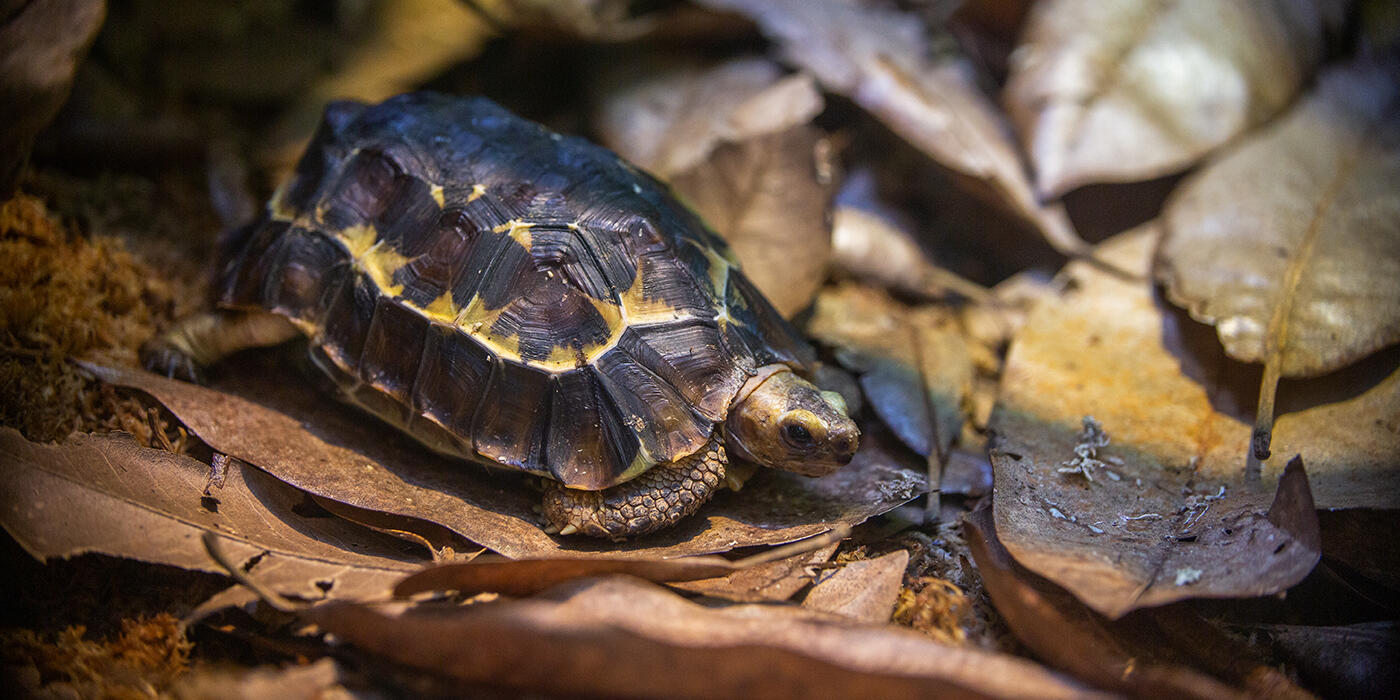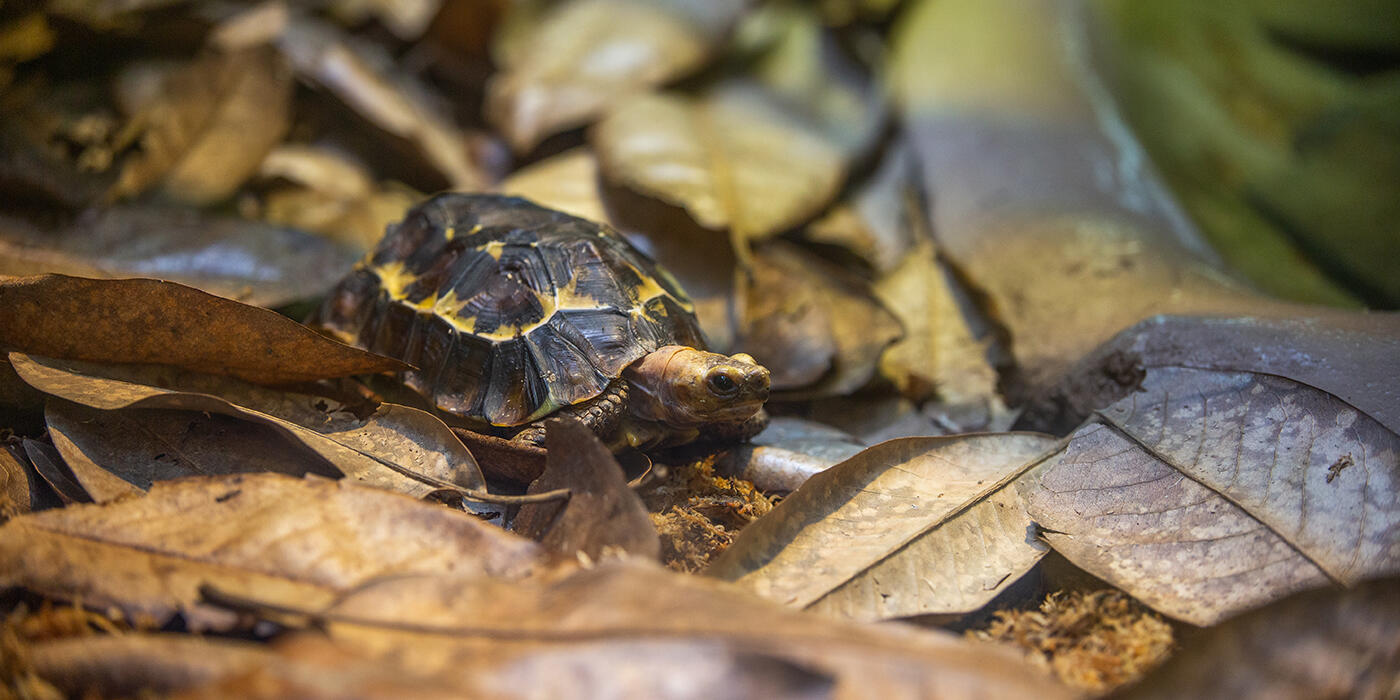Physical Description
This tortoise's carapace, or the top of its shell, is tan to dark brown. The bony plates of the shell, called scutes, are flat, and the carapace angles sharply down at the back.
The front of the shell slopes down toward the tortoise's head, helping to channel rainwater for drinking.The plastron, or the bottom of the shell, is yellow with black spots in the center of the scutes. The tortoise's skin is a brown to yellow color.
Home's hinge-back tortoises belong to a genus of tortoises (Kinixys) that can close themselves within their shells using a hinge at the back of the carapace, rather than a hinge on the plastron. This ability to clamp down the rear portion of their shell to protect their vulnerable tail and back legs is how they earned the name hinge-back.
When threatened, this tortoise can also partially retract its head into its shell and cover the opening with its front legs, which are protected by large scales.
Size
Native Habitat
Home’s hinge-back tortoises are terrestrial forest tortoises, found throughout the coastal regions of the Gulf of Guinea. They have been observed in Liberia, Ivory Coast, Ghana, Togo, Benin, Nigeria, Cameroon, Equatorial Guinea and Central African Republic. They may also reside in the Democratic Republic of Congo and northern Gabon, though more research is needed to understand their complete geographic range.
These tortoises require high humidity and live in subtropical or tropical moist lowland forests, swamps, plantations and similar areas of high humidity. They have been recorded in forest plantations, such as cocoa and coffee farms, in areas that are threatened by forests being cleared for cultivation.
To avoid overheating, hinge-back tortoises prefer closed forest canopies and shady microhabitats. They forage in the shade and rarely bask in sunny spots.
Lifespan
Food/Eating Habits
These omnivorous tortoises eat mushrooms, seeds, plant matter, worms, snails, slugs, spiders, frogs and carrion, but the bulk of their diet is made up of insects, which is unique among tortoises.
At the Smithsonian's National Zoo, they eat leafy greens, fruits, vegetables, earthworms, mealworms, crickets and roaches.
Sleep Habits
These tortoises are mainly diurnal, or active during the day, but they can also be active very early in the morning, at twilight, or in the early nocturnal hours.
Though they can tolerate the high heat of their tropical environment, they tend to prefer shady areas to full sun. Hinge-back tortoises are most active during the wet season and are nearly inactive during the dry months. During the wet season they have been seen using the floods produced by heavy rainfall to float to different areas.
Social Structure
Reproduction and Development
Mating events in the wild have not been extensively studied but have been observed in southern Nigeria from mid-March to the end of May. Male tortoises make mounting vocalizations. Females lay one to four eggs on forest litter or in excavated burrows. They lay eggs one or two times a year, generally in the dry season between December and January.
Hinge-back tortoise eggs are oval or spherical shaped, have brittle shells and measure approximately 1.8 by 1.4 inches (46 by 35 millimeters). Incubation time is thought to be about five months in the wild.
Conservation Efforts
As of a 2006 assessment, the Home's hinge-back tortoise is listed as vulnerable on the International Union for Conservation of Nature's Red List. However, more recent evaluations have reported declines in this species, and its status is provisionally changed to endangered. It is also included among Testudinidae spp. listed on CITES Appendix II.
This tortoise's main threats are harvesting and habitat lost. They are hunted for food, bushmeat markets and traditional medicines, often by people in very poor economic conditions. These tortoises are also collected for trade in the pet industry. As human populations grow, agricultural and industrial expansion also leads to deforestation, which causes significant habitat loss.
Help this Species
Practice ecotourism by being an advocate for the environment when you’re on vacation. During your travels, support, visit or volunteer with organizations that protect wildlife. Shop smart too! Avoid buying products made from animals, which could support poaching and the illegal wildlife trade.
Choose your pets wisely, and do your research before bringing an animal home. Exotic animals don’t always make great pets. Many require special care and live for a long time. Tropical reptiles and small mammals are often traded internationally and may be victims of the illegal pet trade. Never release animals that have been kept as pets into the wild.
Meet the Animals
Smithsonian's National Zoo and Conservation Biology Institute. (n.d.). Home's hinge-back tortoise. Retrieved January 8, 2026, from https://nationalzoo.si.edu/animals/homes-hinge-back-tortoise
Animal News





